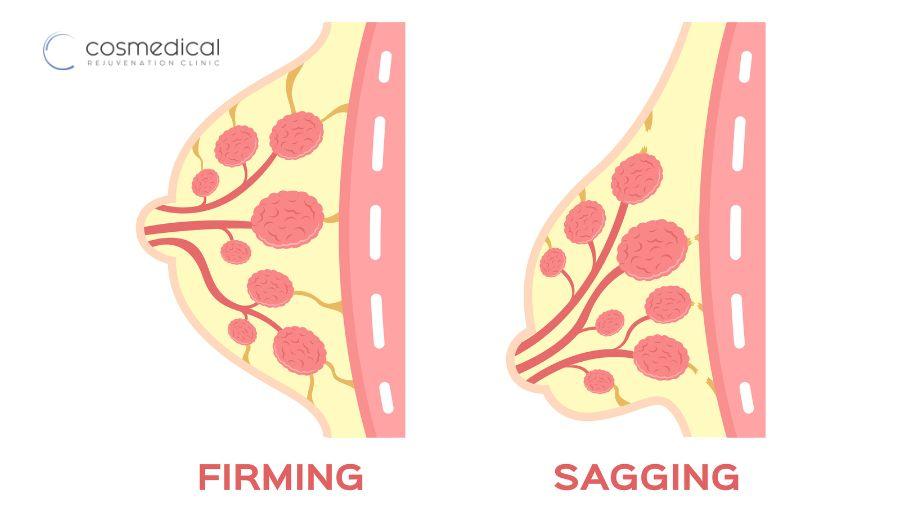
The Shape of the Female Breast
The female breast, a symbol of femininity and motherhood, has been a subject of medical, aesthetic, and cultural interest for centuries. Its size, shape, and the placement of the nipple-areola complex (NAC) play vital roles in its aesthetics and functionality.
Anatomy and Physiology of the Female Breast
The breast is a complex glandular structure, with the nipple-areola complex being a critical component. It consists of the nipple and the surrounding areola. The location of the NAC is typically at the level of the fourth intercostal space or the inframammary fold in a non-ptotic breast. However, various factors can influence its position.
Nipple Placement and Its Importance in Breast Aesthetics and Function
The position of the NAC dramatically influences the overall appearance of the breast. It serves as a critical reference point in breast reconstructive and aesthetic surgery procedures. Proper NAC positioning is vital for achieving a natural and aesthetically pleasing breast contour. Its positioning also plays a crucial role in breastfeeding.
Factors Influencing Nipple Placement
Several factors can affect the position of the NAC. These include aging, gravity, hormonal changes, pregnancy, breastfeeding, and significant weight fluctuations. Each of these factors can stretch Cooper's ligaments, which help maintain breast shape and lead to a downward shift of the NAC.
Discussion on Breast Ptosis: Definition, Causes, and Classification
Breast ptosis, or sagging, refers to a drop in the breast gland and NAC below their normal position. The degree of sagging is classified according to the relative position of the NAC with respect to the inframammary fold and the rest of the breast tissue. The causes of ptosis mirror those that impact nipple placement, with aging and the effects of gravity being primary contributors.
Statistical Data on Nipple Placement and Ptosis
The prevalence of nipple displacement and breast ptosis is quite significant, with various studies suggesting that a majority of women experience some degree of ptosis, especially with advancing age. A study published in the Aesthetic Surgery Journal found that out of 132 patients, 55.4% had grade I ptosis (mild), 29.8% had grade II (moderate), and 14.8% had grade III (severe).
Age isn't the only determining factor. Pregnancy, breastfeeding, and significant weight changes also factor into these statistics. A study in the Annals of Plastic Surgery found that breastfeeding, in particular, was associated with a greater degree of ptosis.
The Impact of Nipple Placement and Ptosis on Women's Health and Well-being
Aside from the aesthetic concerns, abnormal nipple placement and breast ptosis can have profound effects on a woman's psychological well-being. It can lead to body image issues, decreased self-esteem, and even depression.
Breast ptosis can also cause physical discomfort. Severe ptosis can lead to symptoms such as breast pain, skin irritation, indentations from bra straps, and discomfort during physical activity.
Medical Interventions for Nipple Repositioning and Ptosis Correction
Medical interventions for nipple repositioning and ptosis correction mainly involve surgical procedures. These include mastopexy (breast lift), augmentation mastopexy, breast reduction, or nipple-areola complex relocation surgery. The choice of procedure depends on the individual patient's anatomy, degree of ptosis, and personal preferences.
Mastopexy is a common surgical procedure that helps lift and firm breasts that are sagging. It involves removing excess skin and tightening the tissue that remains to reshape and support the new breast contour. If needed, the procedure can include areola reduction and repositioning the nipple to a more natural level.
For women who wish to increase their breast size in addition to correcting ptosis, an augmentation mastopexy can be performed. This procedure involves the insertion of a breast implant in conjunction with a mastopexy.
The placement of the nipple-areola complex and the extent of breast ptosis are significant not only from an aesthetic perspective but also for a woman's psychological well-being and physical comfort. Medical interventions offer effective solutions for women seeking correction of these issues.
Can Saggy Breasts Be Firm Again? Natural Methods to Lift and Tighten Your Breasts
Are you wondering, "Can saggy breasts be firm again?" or "How can I lift my breast naturally?" If you're experiencing sagging breasts, even at a young age, you're not alone. Many women, including those in their 20s, may ask themselves, "Why do I have saggy breast at 20?" Various factors can contribute to sagging breasts, but there are natural ways to help tighten and lift them.
Natural Methods to Lift and Tighten Breasts
1. Exercise: Strengthen your chest muscles with exercises like push-ups, chest presses, and chest flys. Building muscle can help lift and firm the breasts.
2. Maintain a healthy weight: Avoid extreme weight fluctuations, which can contribute to sagging. Maintain a stable, healthy weight through a balanced diet and regular exercise.
3. Wear a supportive bra: A well-fitting bra can help prevent further sagging by evenly distributing your breasts' weight.
4. Hydrate and nourish your skin: Keep your skin hydrated and nourished with fresh water and a healthy diet.
5. Posture: Maintain good posture by keeping your shoulders back and your spine straight. This can help the breasts look perkier.
While these natural methods can help improve the appearance of saggy breasts, it's important to remember that some degree of sagging is natural and inevitable. Embrace your body and focus on maintaining overall health and well-being.